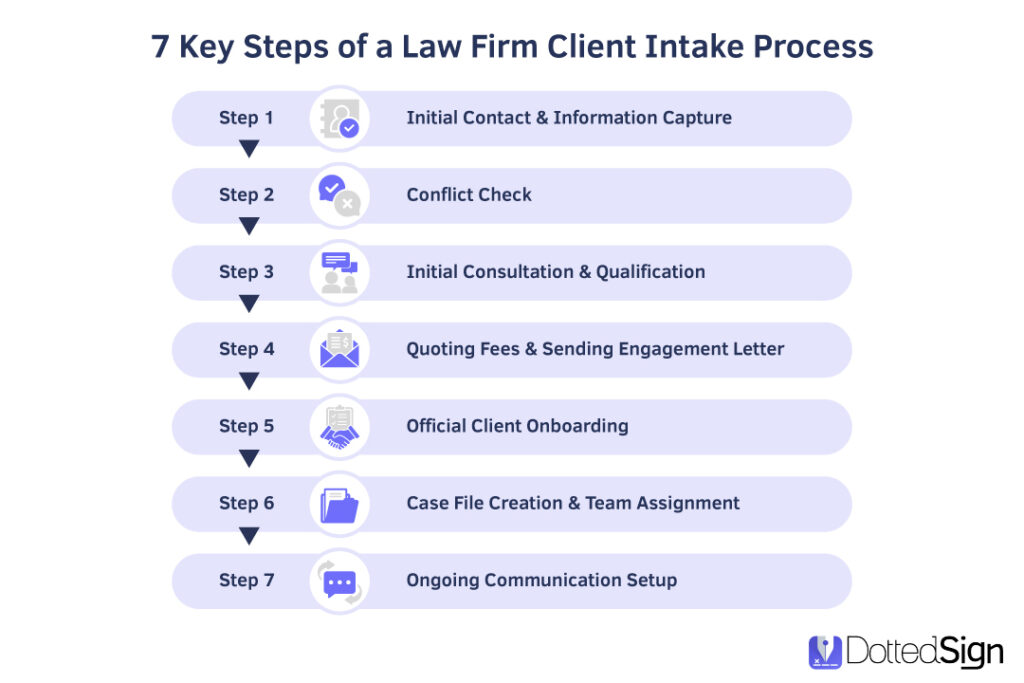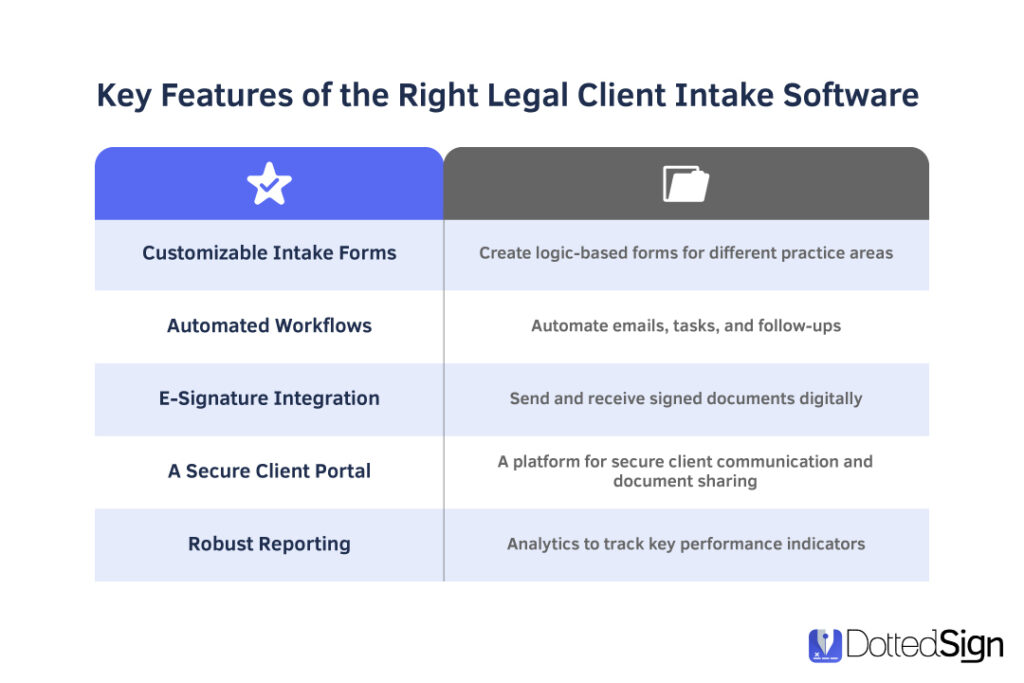Streamline Your Firm: A Complete Guide to the Legal Client Intake Process Flow Chart
Did you know that a potential client’s first interaction with your law firm sets the tone for the entire relationship? According to extensive industry analysis on what it takes to grow your law firm, a clunky, disorganized, or slow intake process can lead to lost opportunities and a poor reputation. Conversely, a smooth, professional, and efficient client intake process not only converts more prospects into paying clients but also lays the foundation for a positive client experience and greater firm profitability. For modern law firms, intake optimization is not just a good idea—it is a competitive necessity to get more clients and thrive.
This comprehensive guide is designed to help you understand, map, and streamline your firm’s client intake process. We will break down the essential steps, provide a clear framework for a law firm client intake process flow chart, and offer actionable strategies for optimization in 2025. By refining your legal intake flow, you can save time, reduce errors, and ensure every potential new client feels valued from the very first click or call.
What is the Legal Client Intake Process? (Client Intake Process for Law Firm)
The legal client intake process is the systematic procedure law firms use to convert a prospective client into a new client while managing risk and compliance. It covers every step from first contact to signed engagement.
Key points:
- Definition: The law firm client intake process flow chart begins when a potential client contacts your firm (via phone, email, or contact form) and ends once the engagement letter is signed.
- Purpose: The legal intake process ensures smooth conversion of leads into paying clients, while safeguarding the firm through essential steps like conflict checks and case qualification.
- Value: A well-structured intake system saves time, protects the firm’s client intake process flow, and improves the overall client experience—helping law firms differentiate from competitors.

2025 Law Firm Client Intake Process Flow Chart
A modern law firm’s client intake process begins the moment intake starts—capturing essential client information, running conflict checks, and moving swiftly to engagement. This process can help teams visualize every handoff, reduce rework, and streamline client intake from first contact to onboarding. With intake optimization for law firms, a clear flow chart improves consistency, accelerates decisions, and lifts client satisfaction across the journey.
Why an Optimized Intake Process is Essential for Your Law Firm
Law firms often invest heavily in marketing to attract leads, but if the intake process is flawed, that investment is wasted. Optimizing this critical first stage of the client journey provides a significant return through improved efficiency and client satisfaction.
Enhancing the Client Experience
The client intake process is your firm’s first handshake. A potential client may be anxious about their legal matter, and a confusing or slow intake process only adds to frustration. Streamlining the process demonstrates professionalism, builds trust early, and sets the tone for strong communication. A positive first experience encourages loyalty and referrals.
Improving Firm Efficiency and Profitability
A disorganized intake process wastes time and resources. By automating data entry, conflict checks, and document signing, firms eliminate bottlenecks and maintain consistency. This allows teams to focus on billable work and improves overall profitability.
The 7 Key Steps of a Law Firm Client Intake Process Flow Chart
Visualizing your intake workflow is the first step toward improving it. Creating a law firm client intake process flow chart provides clarity for your entire team, ensuring everyone understands their role and that each step is handled consistently. Here are the seven fundamental stages of an effective legal intake process for any law firm.

Step 1: Initial Contact & Information Capture
The client intake process begins when a potential new client contacts your law firm through a phone call, email, or a contact form. At this stage, staff should collect basic client information, including details about the legal issue, using a standardized intake form or questionnaire to ensure accuracy.
Step 2: Conflict Check
A mandatory part of any legal intake process, this step verifies no conflicts of interest. Every law firm must perform proper client identification and verification, often supported by case management software, to ensure compliance and protect against ethical risks.
Step 3: Initial Consultation & Qualification
At this stage of the intake process, the prospective client shares details of their matter. The firm evaluates whether it can serve this specific client and also screens for red flags of fraud or other illegal activity before moving forward.
Step 4: Quoting Fees & Sending Engagement Letter
Once qualified, the firm outlines fees and scope of work. Using a secure eSignature solution like DottedSign, firms can send engagement letters digitally, making it easy for clients to review and sign quickly from any device.
Step 5: Official Client Onboarding
The onboarding process ensures the new client is formally welcomed, introduced to the team, and guided on the next steps in the legal process. This stage reinforces trust and sets a clear roadmap for the upcoming legal work.
Step 6: Case File Creation & Team Assignment
All gathered client intake information flows into the firm’s client management system. The case is assigned to the right attorney and staff.
Step 7: Ongoing Communication Setup
The firm establishes communication channels, such as a client portal, ensuring consistent updates and a better client experience.
How to Build an Effective Legal Client Intake Form
The client intake form is the backbone of your data collection process. Whether digital or physical, a well-designed form ensures you gather all necessary information consistently and efficiently. It’s the primary tool for your firm’s client intake process.
Essential Information to Collect
An effective legal client intake form should be comprehensive but not overwhelming. Intake forms often include sections for:
- Basic Contact Information: Full name, address, phone number, email.
- Case Details: A summary of the legal issue, key dates, and relevant events.
- Opposing Party Information: Names of all individuals or entities involved on the other side (critical for conflict checks).
- Source of Referral: How the client heard about your law firm (valuable for marketing analysis).
- Communication Preferences: How the client prefers to be contacted.
- Authorization for Representation: A clear statement authorizing the firm to begin preliminary work, like the conflict check.
Digital vs. Paper Intake Forms
While paper forms still exist, modern law firms are rapidly adopting digital solutions. A digital client intake form, often integrated into your firm’s website or a client portal, offers significant advantages. It allows a potential client to provide information at their convenience, reduces data entry errors for your staff, and can automatically feed data into your client relationship management (CRM) or legal software. This automated intake approach saves time and makes the process more convenient for every client.

How to Streamline and Optimize the Client Intake Process?
A good intake process is effective; a great one is efficient. Intake optimization for law firms involves identifying bottlenecks and leveraging technology to create a faster, smoother experience for both clients and staff. The goal is to streamline your client intake from start to finish.
1. Automate, Automate, Automate
Automation is the key to efficiency. You can automate responses to confirm receipt of web form submissions, send appointment reminders, and use templates for engagement letters. For instance, DottedSign’s template system allows you to pre-fill documents and save hours of manual work.
True workflow automation connects every stage of your legal client intake process. When a potential client submits an online intake form, the system can automatically:
- Create a CRM contact record and run a conflict check.
- Send a confirmation email with next steps.
- Assign review tasks to your intake specialist.
These connected workflows ensure no lead is left waiting and that your team remains focused on higher-value work.
2. Utilize Client Intake Software
Dedicated client intake software or a comprehensive case management software with intake features is a game-changer. These tools centralize all intake activities. They can manage online forms, automate conflict checks, schedule consultations, handle e-signatures for engagement letters, and provide analytics on your intake process. Using leading legal software is one of the fastest ways to improve your law firm’s efficiency.
3. Standardize Your Intake Procedures
Consistency is crucial. Every person involved in the intake process at your law firm should follow the same steps every time. Create documented intake procedures and checklists that outline each stage, from the first call to the final onboarding step. This aligns with general basic management best practices that successful firms employ to ensure quality control. Standardization reduces errors, ensures a high-quality client experience for every client, and makes it easier to train new staff. Effective intake procedures are the foundation of a scalable law firm.
Workflow Automation for Intake Optimization
Platforms that offer API integrations, such as DottedSign API, are essential for building these connected workflows, allowing different software systems to communicate and act without manual intervention. This creates a seamless flow from first contact to signed client.
Choosing the Right Legal Client Intake Software for Your Firm
Selecting the right technology is a critical step to optimize the client intake process. The market for legal tech is vast, but focusing on the specific needs of your law firm can help you choose the best legal client intake software.

Key Features to Look For
- Customizable Intake Forms: The ability to create detailed, logic-based forms that adapt to different practice areas.
- Automated Workflows: Tools to automate emails, tasks, and follow-ups.
- E-Signature Integration: The ability to send and receive signed engagement letters digitally. Look for solutions that provide a full audit trail for legal validity.
- A Secure Client Portal: A platform for clients to securely share documents and communicate with your firm.
- Robust Reporting: Analytics to track conversion rates, lead sources, and other key performance indicators.
Integration with Your Existing Systems
The best legal software does not exist in a vacuum. Ensure the client intake software you choose integrates seamlessly with your existing tools, such as your practice management software, billing system, and email client.
For example, DottedSign integrates with platforms like Salesforce and Google Drive, ensuring that signed documents and client data flow smoothly from the initial intake to active case management, creating a unified system for your entire firm. This integration prevents the need for double data entry and ensures that information flows smoothly. Many law firms use integrated systems to improve efficiency.
Common Pitfalls in the Law Firm Intake Process (And How to Avoid Them)

Common pitfalls in the law firm intake process can create inefficiencies. Even successful law firms may struggle if they overlook the basics of a well-designed intake process.
1. Poor Communication and Slow Response Times
Speed matters in the legal world. A potential client may contact multiple law firms, and if your firm is slow to respond, you lose the lead. A well-designed intake process with automated follow-ups ensures every potential client feels valued.
2. Inconsistent Data Collection
Different methods create errors and wasted time. A standardized legal client intake form captures all key information consistently, especially for conflict checks.
3. Neglecting the Conflict Check
Skipping this step is one of the most dangerous mistakes a law firm can make. It risks ethical violations and malpractice. Every intake process must include a mandatory conflict check before consultations.
Frequently Asked Questions (FAQ)
1. What Are the Key Stages of the Client Intake Process for a Law Firm?
The key stages are: 1. Initial contact & information capture, 2. Conflict check, 3. Initial consultation & qualification, 4. Quoting fees & sending engagement letter, 5. Official client onboarding, 6. Case file creation & team assignment, and 7. Ongoing communication setup.
2. What is the Main Purpose of a Legal Client Intake Form?
Its main purpose is to efficiently and consistently gather essential information from a potential client. This includes contact details, case facts, and information for conflict checks, ensuring the firm can properly evaluate the case and manage risk.
3. How Can I Streamline My Law Firm’s Client Intake?
You can streamline the process by using digital intake forms, automating communication like reminders and follow-U.S, using esignature software for engagement letters, and integrating your intake tools with your case management software to eliminate duplicate data entry.
4. What Software is Best for Legal Client Intake?
The best software integrates seamlessly with your existing practice management system. Look for features like customizable forms, workflow automation, e-signature capabilities, and robust reporting. A solution like Dottedsign is crucial for the signature-gathering part of the process, ensuring it is fast and legally binding.
5. Why is a Conflict Check So Important During Client Intake?
A conflict check is crucial for ethical compliance. It prevents your firm from representing a client whose interests are adverse to those of a current or former client, which could lead to disqualification from a case, disciplinary action, and malpractice claims.
6. How Long Does a Law Firm Have to Keep Client Files?
While not part of initial intake, understanding file retention is important from the start. Most jurisdictions require law firms to keep client files for five to seven years after representation ends, though some cases—like those involving minors or estate planning—may need longer retention. Check your local bar rules and communicate this policy during onboarding to set clear expectations.
7. How Can Automation Improve the Client Intake Process?
Automation reduces manual administrative work, which saves time, minimizes errors, and ensures faster response times to potential clients. It can handle tasks like sending confirmation emails, scheduling reminders, and generating template documents, freeing up staff to focus on higher-value activities.
Key Takeaways
Optimizing your law firm client intake process is one of the highest-impact investments you can make in your firm’s growth and long-term success. A streamlined, client-focused intake system is a powerful tool for converting leads, enhancing your reputation, and improving your bottom line.
To summarize, here are the 3 key points for building an effective legal intake process:
- Map and Standardize Your Process
Define a clear client intake process flow with consistent steps and use a standardized client intake form to capture accurate information. - Prioritize Client Experience and Team Training
Ensure your law firm delivers a transparent, respectful journey for every potential client, and train staff to follow a well-designed intake process. - Leverage Technology to Streamline
Adopt client intake software and eSignature tools like DottedSign to automate tasks, reduce errors, and modernize workflows.
Ready to streamline your client intake? Explore DottedSign to optimize your legal intake process—Request a Demo or start a 14-day Business Trial today.


